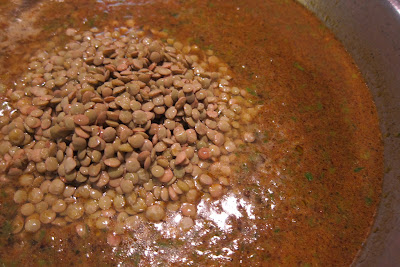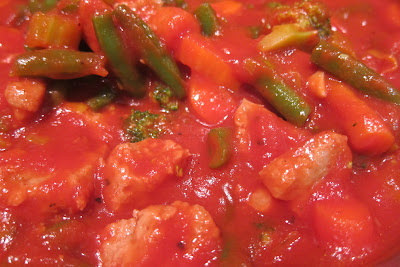The first day of September is just a few days away, so I'm starting to feel like summer is ending. I'm looking forward to the fruits and vegetables that will be locally available in the fall - like squash, apples, and more greens. But I definitely have not experienced a dearth of different ways to prepare the familiar lineup of vegetables I've been eating the last two months. This dinner idea began with noticing that the bottom drawer of the refrigerator had a plentiful amount of beets. I turned to my two vegan cookbooks on loan from the library and was happy to find this recipe that uses beets as a main ingredient: Scarlet Roasted Vegetables, from Alicia Silverstone's "The Kind Diet" book.
This book has lots of recipes, categorized into two "intensities" of vegan-ness: Vegan and Superhero. It also has lots of great food pictures to go with the recipes, as well as a number of informative chapters on meat, dairy, processed foods, and nutrition.A fair amount of recipes involve using ingredients I'd imagine most people are unfamiliar with (mochi, umeboshi vinegar) or aren't able to buy at common grocery stores (hemp seeds, brown rice syrup). Although, I do prefer the challenge of finding new foods in a grocery store over searching for new shoes. In addition, many recipes can be altered or simplified, and a bunch use pretty common ingredients. The "Scarlet Roasted Vegetables" recipe is one that I definitely quirked, found very simple to do, and I'm sure tasted just as great as its by-the-book inspiration.
My dad gave me some help by cutting up carrots and yellow beans...
... as well as boiling the beets (to make the skins fall off and save time with peeling). I cut up some zucchini and yellow squash to add to the party bowl. Then I gathered the different spices and flavors that would amalgamate and awaken all the vegetables into its delicious scarlet beauty.
Lemon zest (grated from the peels of two lemons), the juice of one lemon, soy sauce, a few bay leaves, parsley, sliced almonds, leeks and halved dried apricots.
It's fun to add something hardy and crunchy (almonds) and something sweet and chewy (dried apricots) to the vegetable medley. I tossed all those ingredients in a big bowl with all the vegetables, along with some olive oil, and combined it well. (The beets were peeled, cubed and added after I took this picture.)
Then I spread out the whole lot over two lightly oiled baking pans.
It does take some time to cut up all these vegetables and flavorings, and then another 40 minutes while it bakes in the oven, but the result is unbeatable.
With some fresh lemon juice squeezed on top of each warm helping, every bite was juicy and robust. With tasty meals like this, it's easy to want to skimp on the chewing and quickly feed yourself forkful after forkful. But since I only let the veggies roast to a nice tenderness that's far from mushiness, the process of eating them provides a nice opportunity to chew on your thoughts while your mouth is closed for extended periods of time. Better chewing makes happier digestion!
The beets did indeed bleed enough to create some fun color swapping. A sugary surprise appeared in every few bites from the dried apricots. Careful crunching of almonds intensified the need to chew thoroughly. All the vegetables contributed to flavor variety. And all loved ones were happy and satiated on the dinnertime home front.
Here's the recipe from the book. (I used a larger quantity of vegetables than called for, so I upped the quantity of almonds, leeks, parsley, dried apricots, bay leaves and soy sauce.)
4-6 shallots, peeled and halved lengthwise (I used leeks)
3 large beets, cut into 1" chunks
2 parsnips, quartered lengthwise (I heard these have a sweet taste, which would have gone great with this recipe; but I used the carrots I had on hand instead)
1 large fennel bulb, halved, cored, and thickly sliced (I don't even know what a fennel bulb is, so I left it out)
1-2 cups kabocha squash, cut into big chunks (peel only if not organic) (I used the zucchini, yellow squash and yellow beans I had on hand instead)
3-4 celery stalks, cut in 1" pieces (I didn't have any celery either, so I left it out)
3-4 dried bay leaves
1/2 cup pecan halves (I used some almonds I had in the cupboard instead)
6-8 dried apricots, coarsely chopped
1-2 tsp shoyu (that's the Japanese name for "soy sauce")
Grated zest of two lemons
2-3 Tbs olive oil
Juice of 1 lemon
2 Tbs fresh parsley
Preheat oven to 350 degrees F. Lightly oil one or more large baking sheets.
Combine all ingredients in a large bowl. Mix to coat the vegetables well.
Spread out vegetables evenly on baking sheets.
Cover with aluminum foil and roast for 40 minutes, or until vegetables are soft when pierced.
Remove foil and roast for another 15 minutes to let the vegetables brown a little. (I only did about 5-10 minutes without the foil because we were huuungry!)
Remove from oven, toss with lemon juice, and garnish with parsley. (I mixed the parsley in with the vegetables and had it all cook together instead.)
Now get out there and create something colorful to decorate your plates and feed your tummies!





























































